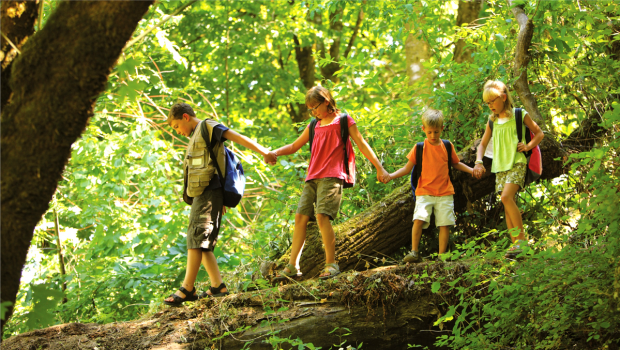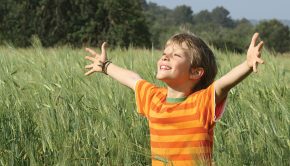INTO THE WOODS
Nature Helps kids Build Skills and Character
by April Thompson
A movement is afoot to get kids grounded in nature. Wilderness awareness programs, also known as primitive skills or Earth-based education, teach life-changing survival skills that build courage, compassion and camaraderie.
“We help youth experience a true aliveness in nature. Kids gain knowledge of the outdoors and increase awareness, confidence and self-reliance, while having fun, positive experiences,” says Dave Scott, founder of the Earth Native Wilderness School (EarthNativeSchool.com), in Bastrop, Texas. They often go on to enthusiastically share what they’ve learned about natural flora and fauna with their families.
Experiential Learning
Youth engaged with organizations like this one enjoy gaining nature-oriented survival skills, such as making bows, baskets, shelters and fire. “By making a bow out of a particular type of tree, children discover what type of habitat the tree prefers and how to harvest it sustainably. Indigenous skills like animal tracking also help them relate to wildlife and develop empathy for animals,” says Scott.
“When you learn to trust rather than fear nature, you’re more likely to take care of it,” adds Rick Berry, founder of 4 Elements Earth Education (4eee.org), a Nevada City, California, nonprofit that helps kids and adults connect with planet Earth via immersion in nature. Leaving room for spontaneity and improvisation is important.
While infusing indigenous knowledge into their curriculum, wilderness programs emphasize universal principles such as deep understanding of local environments and life’s interconnectedness. “Fire making is for everybody. Shelter making is for everybody. We are all caretakers of the land,” says Berry
Physical and other challenges, such as walking blindfolded through the woods, heighten sensory perception while building confidence. “The landscape is a great teacher with its uneven ground and obstacles, posing an opportunity to learn agility, practice balance and ultimately, expand awareness,” says Simon Abramson, associate director of Wild Earth (WildEarth.org), in High Falls, New York.
Nature-immersion programs like Wild Earth’s further help kids sharpen their observation skills through activities like learning to identify birdsongs and trees. During a popular activity called “sit spot”, children learn to sit quietly, listen and observe from a specific location they may revisit over the course of a day or year to witness nature’s varied beauty. Another time, they may try “foxwalking”, creeping silently and slowly, or test their “owl vision”, using peripheral vision. For younger kids, instructors may incorporate such skills into a game like “coyote or rabbit,” where by staying still, they can avoid detection by a predator.
Kids learn to listen both to nature and their own inner voice, which can be challenging in the midst of dominating peers and authority figures. “We build on the tradition of vision quest, in taking time to get quiet in nature and hear what the heart is saying,” says Berry.
Activities may be patterned after natural cycles of the seasons, the four directions and diurnal rhythms. On a bright morning, emphasis is on high-energy, outward-facing activities; day’s end brings a pause to reflect, glean and share what participants have made and learned.
Lasting Life Lessons
Mother Nature’s lessons can be hardearned, but the outdoor trials that kids experience are often their most honored and memorable moments. Whether youths try out a wilderness program for a season or stay on for years, Earth-based learning can have an enduring impact.
They help foster healthy relationships not only with the Earth, but with other people, according to Samuel Bowman, a program coordinator with the Wilderness Awareness School (Wilderness Awareness.org), in Duvall, Washington. Team-driven activities like building a communal shelter can help kids learn how to work through conflict, listen to others and appreciate differences.
“The kids that have come through our programs prove to be creative problemsolvers prepared to handle just about anything. They have focus and commitment, and tend to be service oriented,” observes Abramson, noting that 60 percent of their instructors are alumni.
“Thinking back on kids we’ve worked with, you can often see their wilderness journey reflected in their paths as adults, how they are making choices with their heart and pursuing their passions,” concludes Berry.
Connect with April Thompson, in Washington, D.C., at AprilWrites.com.
Image: Hurst Photo/Shutterstock.com
<












